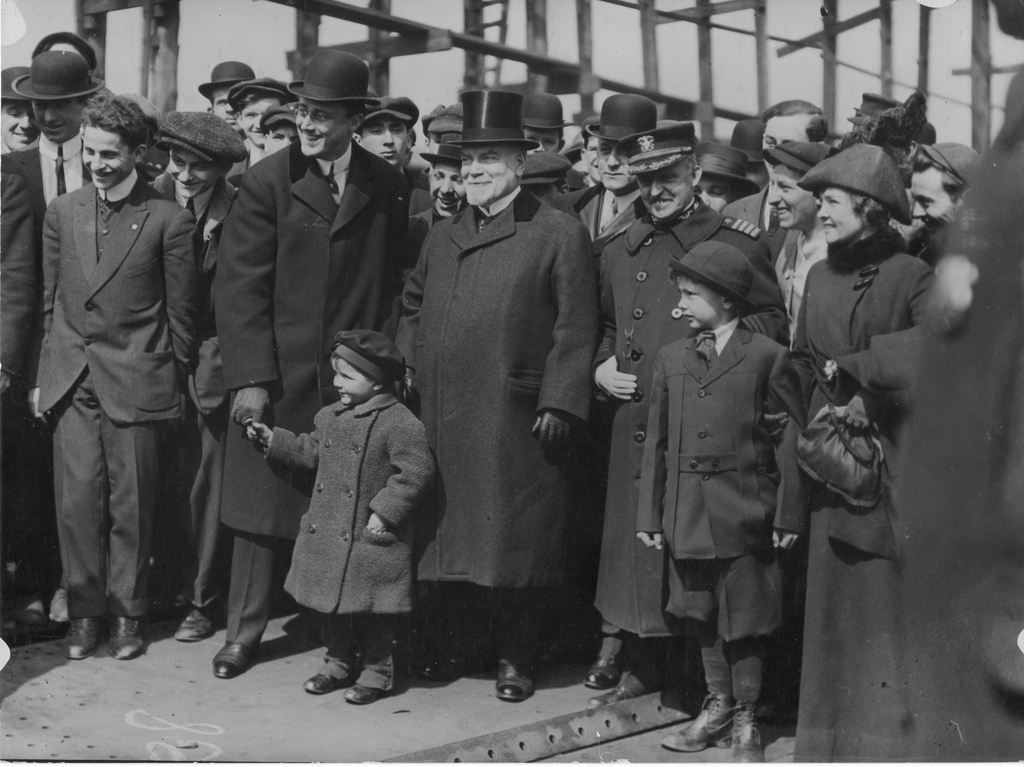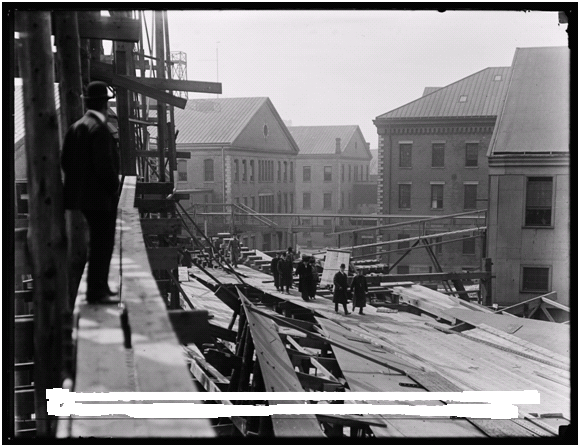Teach American History Blog
An (Almost) Accidental Discovery
Sometimes it is better to be lucky than good. At least, that is what I always tried to tell myself when I was playing sports in school! Through the academic "grapevine," I received a link to an interesting photo that had been "discovered" by a digitizer named Michael Horsley at the National Archives. He and a partner were working through a giant collection of plate glass negatives, scanning them for digital use, when Horsley decided to get a closer look at one just scanned. It was a photo taken in the Brooklyn shipyard on May 16, 1914. (The full story and photos can be found here.)
There are obviously several figures in the photo; most are part of the group walking towards the camera, while a solitary figure (a laborer, perhaps? My guess is no, as he seems to nicely dressed) watches from the higher position to the left. This is a new battleship under construction. They are preparing to begin laying the keel, a process that will take over a year to complete. The group walking toward the camera are, for the most part, Navy officials and family members who will take part in a ceremonial keel-laying event. This image might have gone unnoticed for a long time if it were not for the photo's information (which I erased in the above image).

It was the F.D. Roosevelt that caught Horsley's eye. It might be impossible to tell, with this large of an image, that Roosevelt is there at all. But he can be clearly seen when the pertinent part of the image is enlarged.

Additional research confirmed that FDR was, in fact, Assistant Secretary of the Navy in 1914. But there are additional items to consider in this image. First of all, one should notice that FDR does not appear as we often visualize him. Since we picture FDR as President, after he was struck with polio, the modern mind often envisions him in a wheelchair more often than not. But in 1914 he had not contracted polio yet! So it is odd to see him tall and striding briskly across the work zone. Second of all, the battleship under construction is labeled as number 39. For afficionados of the Second World War may already know which battleship that becomes: the USS Arizona, sunk during the surprise attack at Pearl Harbor when FDR was no longer Assistant Secretary of the Navy but was President of the United States. In one more of those odd moments in history, FDR toured the battleship being built in 1914, whose destruction in 1941 would propel his Presidency with a flood of domestic support into a massive global conflict.
That would be enough of a tale, but it turns out there is more. Another researcher, reading the blog post by Horsley, linked to another photo, this one that displays part of the official ceremony involving those officials. There is FDR in the front, smiling, and holding the hand of a small child. The children in the photo were part of the keel-laying ceremony; they would be allowed to place the first bolts in place. (The story of this photo can be found here.) The children would place nickel-plated ones, which would later be removed and replaced with steel bolts (and the children, then, could keep theirs as a souvenir).

There is one more twist to this narrative, though, that is recounted by an archivist for the FDR Presidential Library and Museum (which owns the rights to the above photo). The little boy in the picture is named Henry Williams, Jr. Years later, he will be a lieutenant in the US Navy, stationed at Pearl Harbor, and will be a witness to the destruction of the USS Arizona. As the archivist noted, "one cannot help but wonder what his feelings were at that moment, having been present at Arizona's very beginning and at her very end."
From my experience, it is just these sorts of coincidences that help students find an interest in history. I always enjoyed those "No way!" moments. On top of that, these kinds of historical oddities also can help our students remember key details (Why would we be building a massive battleship in 1914? What happened at Pearl Harbor?). What other ways could these images be used in your classrooms? Are there other historical oddities like this that you already use to help students connect to the material?
Posted by Jason Mead - Tuesday, 03/20/2012, 08:36 AM - Comments -
| December 2025 | ||||||
| Sun | Mon | Tue | Wed | Thu | Fri | Sat |
| 1 | 2 | 3 | 4 | 5 | 6 | 7 | 8 | 9 | 10 | 11 | 12 | 13 | 14 | 15 | 16 | 17 | 18 | 19 | 20 | 21 | 22 | 23 | 24 | 25 | 26 | 27 | 28 | 29 | 30 | 31 |
Categories
No categories found.Monthly Archives
Recent Posts
- Changes to the Wiki
- President's Day: Lincoln
- Inauguration
- Out of the Box Teaching Tools
- Election Day
- TNCHE
- Presidential Campaign Posters
- Interactive Posters, Reading Primary Sources, and Milestone Documents
- What Was There- Local History Meets Technology
- Introducing Ashleigh and Favorite Library of Congress Links
- All Sorts of Fun
- An (Almost) Accidental Discovery
- At What Price Freedom?
- All Work and No Play (and No School) . . .
- Forgotten Wars
- The Haziness of Memory
- Handling Race and Reconstruction in Our Classrooms
- Disasters in Human History
- Who Doesn't Love a Good Conspiracy . . .
- May is a busy month . . .
